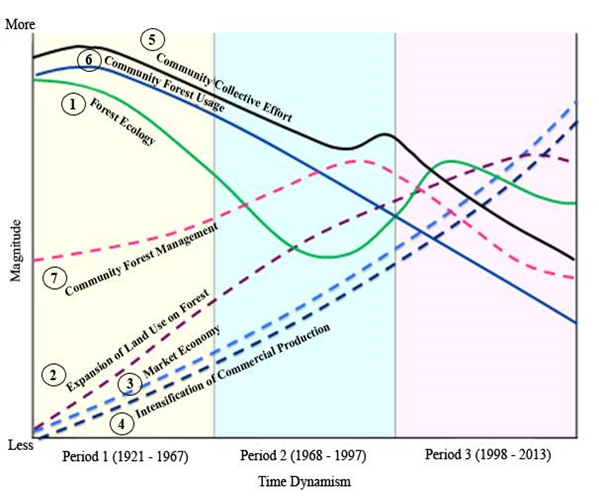Stagnation of Community Forest Management: A Case Study of Nam Kian Sub- District, Phupiang District, Nan Province
Main Article Content
Abstract
The Study on Stagnation of Community Forest Management: A Case Study of Nam Kian Sub-District, Phupiang District, Nan Province aims to investigate the development of community forest management from the beginning to the present time and to use a new paradigm on the description of the forest community management in the context of a highly complex and dynamic approach by using Nam Kian as the case study. The community forest management of the Nam Kian community is one of the most empowered. Nevertheless, the forest management, which was formerly well managed, has weakened and stagnated. The study found that the community forest management has been evolving continuously. In fact, it is correlated and modified by complex factors, of which there are at least seven. These being; 1) forest ecology 2) expansion of land use on the forest 3) market economy 4) intensification of commercial production 5) community collective effort 6) community forest usage 7) community forest management. It has been shown that the change of the first five factors affect the later two factors which have moved through a dynamic change in the dimension of time in each period. In the current situation changes of the five factors, as mentioned above, affected the relationship between the community and the usage and management of community forests. It has shown the adaptation efforts of the villagers, who attached extreme importance to the economic dimension and commercial production, at a cost of diminished importance of other dimensions, especially community forest management. The stagnation of community forest management in this study is explained well and poses a different explanation from the political ecology. The stagnation of the community forest does not come from state power mainly. It is not an ongoing increment of community forest management that depends on wisdom or cultural vitality of the community. It is a combination of complex factors, especially the approach of the full market economic system, the intensive commercial production, land use, labor and inputs. They affect the ecosystems and decline of biodiversity and reduce the community collective effort. Therefore, the potential of forest management is reduced. This is the phenomenon of describing the stagnation of community forest management in the real situation.
Article Details
Published articles are under the copyright of the Environment and Natural Resources Journal effective when the article is accepted for publication thus granting Environment and Natural Resources Journal all rights for the work so that both parties may be protected from the consequences of unauthorized use. Partially or totally publication of an article elsewhere is possible only after the consent from the editors.

